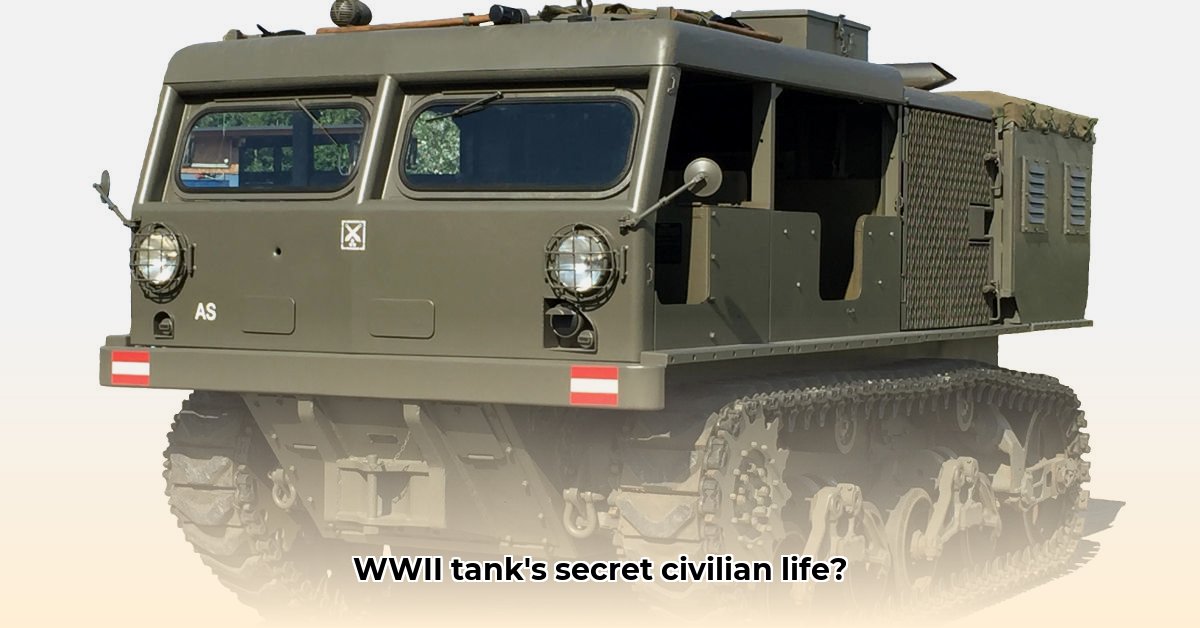
The M4 High-Speed Tractor, a product of World War II ingenuity, transcended its military origins to become a versatile workhorse in the postwar era. Its story is one of remarkable adaptability, showcasing the enduring impact of a machine originally designed for the battlefield. This article delves into the M4's design, its wartime service, its surprising civilian applications, and its lasting legacy. We will explore its unique features, particularly its Horizontal Volute Spring Suspension (HVSS), and examine its contributions to both military logistics and post-war reconstruction. Further, we will consider the broader implications of adapting military technology for civilian use. For more in-depth information, visit the M4 Tractor website.
M4 High-Speed Tractor: A Wartime Necessity
The M4 wasn't just another tractor; it was a critical component of the Allied war effort. Born from the urgent need for reliable artillery support, the M4 cleverly incorporated existing Sherman tank components, including tracks, wheels, and even the drive system. This innovative strategy drastically reduced production time and cost, a crucial advantage during the war. Over 5,400 units were produced, a testament to its importance. But how did this streamlined design translate to real-world performance on the battlefield? The answer lies in its effective towing capacity, allowing for rapid deployment and maneuverability of heavy artillery pieces. This speed and efficiency were vital in the dynamic and often unpredictable conditions of WWII combat.
Did the M4's design truly maximize efficiency in wartime? The impressive production numbers alone suggest a resounding yes. This strategic utilization of existing tank parts not only accelerated production but also conserved valuable resources, allowing for greater allocation to other critical war materials.
From Battlefield to Barnyard: Adapting to Peacetime
The M4's story doesn't end with the cessation of hostilities. Its robust construction and adaptable design proved invaluable in the civilian sphere. The Mutual Defense Assistance Program (MDAP) facilitated the M4's global distribution, aiding in post-war reconstruction efforts across the globe. But its impact extended far beyond international aid. Farmers embraced the M4's power for plowing, logging companies found it ideal for hauling timber, and construction crews used it for moving heavy materials. This adaptability highlighted the M4's inherent versatility and the foresight of its designers. How did such diverse industries find a use for this seemingly specialized machine? The answer lies in the M4's robust construction and power-to-weight ratio, making it suitable for a variety of tasks requiring heavy-duty hauling and maneuverability in challenging terrain.
Was the M4's civilian success purely coincidental, or a direct result of its design? The widespread adoption across diverse industries points towards a deliberate design philosophy that prioritized robustness and adaptability.
Design Innovations and Upgrades: Continuous Improvement
The M4 wasn't static; it evolved throughout its lifespan. The "duckbill" track version, mirroring modifications made to the Sherman tank, improved traction and handling, especially in soft or muddy conditions. This continuous improvement underscores the dedication to enhancing the M4's performance. Further adaptations, such as the Finning Tank Drill, showcase its flexibility and potential for further modification. Such adaptability speaks volumes about the original design’s inherent strength and the foresight of its engineers. These iterative improvements demonstrate a commitment to ongoing optimization, ensuring the M4 remained a relevant and effective tool throughout its operational life.
What specific design elements contributed to the M4's adaptability? The modular nature of its components, coupled with its robust chassis, enabled relatively easy modification and customization to suit various applications.
The HVSS: Unveiling a Suspension Mystery
The M4's Horizontal Volute Spring Suspension (HVSS), inherited from the Sherman tank, significantly influenced its performance. While similar to the Sherman's system, a detailed comparative analysis is lacking. How precisely did the HVSS improve ground pressure, efficiency, and off-road capabilities compared to other contemporary suspension systems? This remains a significant area for future research, possibly revealing a more nuanced understanding of the HVSS's contribution to the M4's overall success. Preliminary research suggests the HVSS's unique design offered a smoother ride and enhanced traction across diverse terrain. However, rigorous quantitative data is needed to support this hypothesis fully.
How might a comparative analysis of the HVSS aid in our understanding of the M4's success? Such research could provide quantitative data on ground pressure, efficiency, and terrain adaptability, showcasing the precise advantages of the HVSS system compared to alternative designs.
The M4's Enduring Legacy
The M4 High-Speed Tractor's story is more than just a historical account; it's a testament to ingenuity and adaptability. From its crucial role in World War II to its diverse civilian applications, the M4’s impact on military logistics, technological innovation, and the repurposing of military technology is undeniable. Its legacy serves as a powerful example of the potential for innovation and resourcefulness to achieve remarkable long-term impact.
What lessons can we learn from the M4’s success? The M4’s enduring legacy emphasizes the importance of robust design, adaptability, and the potential for repurposing military technology for civilian applications. Further research into its economic and societal impact could offer even more valuable insights.
Key Takeaways:
- The M4’s efficient design, leveraging existing Sherman tank components, greatly accelerated its production and deployment during WWII.
- Its remarkable adaptability led to widespread civilian adoption across diverse sectors, from agriculture to construction.
- The M4's HVSS suspension played a significant role in its success, although further research is needed to fully quantify its impact. The M4’s legacy showcases the potential of military technology to create enduring value in diverse civilian applications.
This comprehensive review highlights the M4 High-Speed Tractor's remarkable journey from vital wartime equipment to a versatile civilian workhorse, underscoring the enduring power of innovative design and adaptation.